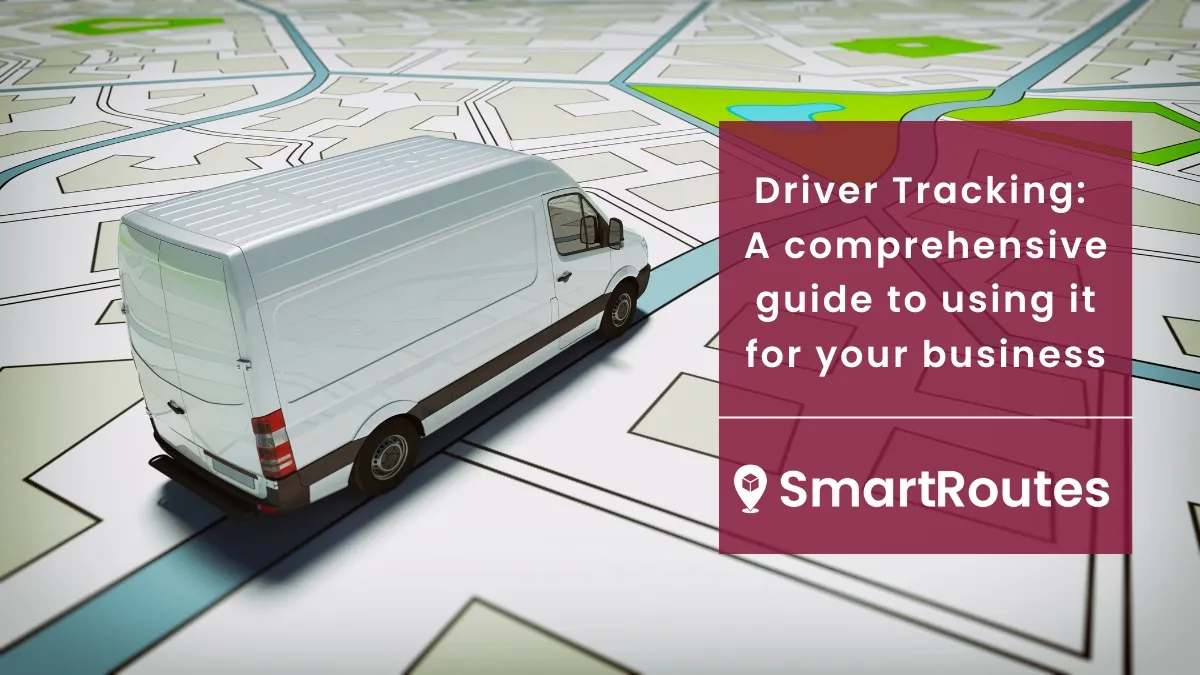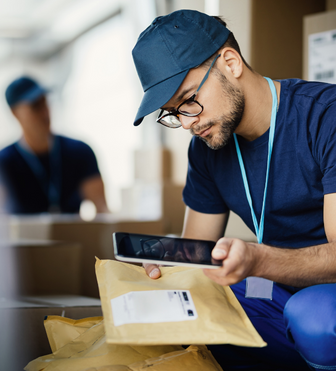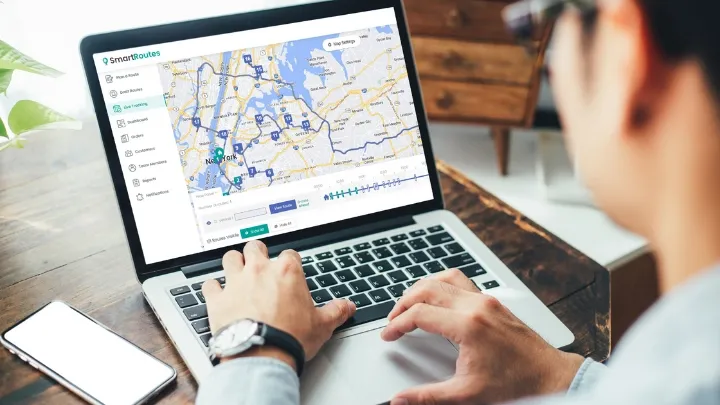Driver Tracking for Business: A Practical Guide to Smarter, Simpler Fleet Oversight
Learn how GPS driver tracking streamlines fleet management, boosts delivery efficiency, and improves customer satisfaction—without high setup costs.

If you're managing a delivery operation and spending too much time on phone calls, WhatsApp messages, or rerouting drivers manually, it’s likely you’ve outgrown your current system. What used to work with one or two vans starts to break down as your fleet grows—and that’s where driver tracking comes in.
This guide explains how driver tracking works, why it’s a game-changer for growing delivery businesses, and how SmartRoutes offers a simple, cost-effective way to take control of your fleet.
Table of Contents
- What Is Driver Tracking, and Why Should You Care?
- What Driver Tracking Solves
- Two Main Approaches to Driver Tracking
- The SmartRoutes Difference: Designed for Delivery
- But Won’t Drivers Push Back on Being Tracked?
- Case Study: Grocery Delivery Business Gains Efficiency with SmartRoutes
- Getting Started: It’s Easier Than You Think
- Frequently Asked Questions
What Is Driver Tracking, and Why Should You Care?
Driver tracking is the use of GPS technology to monitor where your drivers are in real time. In practice, it means knowing where each vehicle is on the road, how far along they are in their route, and whether deliveries are running on schedule.
It’s often referred to as fleet tracking or delivery tracking. But whatever name it goes by, the purpose is the same: to give you oversight without micromanagement, and confidence without constant follow-ups.
Instead of wondering where delivery drivers are or relying on updates via calls and texts, you get a clear picture of your operation in motion. For businesses doing last-mile delivery, this visibility quickly becomes essential—not just for operational efficiency but for customer satisfaction too.
SmartRoutes Route Planning Software
Streamline your entire delivery process, all from one platform

What Driver Tracking Solves
As delivery operations expand, they tend to hit the same pain points: missed deliveries, customer queries about ETAs, and a lack of real-time visibility when things go wrong.
Driver tracking helps businesses address all of these challenges in one move.
You’ll gain the ability to respond to customer questions with accurate, real-time updates. You'll see whether drivers are on track or falling behind, and you’ll have a record of completed stops and delivery times. Over time, this data can even help you refine routes and improve planning.
Security is another benefit. In the rare event that a vehicle goes missing, having tracking in place gives you immediate insight into its last known location. Even more commonly, tracking discourages unauthorized vehicle use and helps reduce risk.
With these capabilities, delivery managers can shift from constantly reacting to confidently managing.
Two Main Approaches to Driver Tracking
1. Hardware-Based GPS Tracking Devices
This method uses physical GPS units, typically plugged into a vehicle’s onboard diagnostics (OBD) port. These devices activate when the vehicle starts and tracks location, and driver performance metrics and behavior—things like speeding, harsh braking, or cornering.
They’re reliable and difficult to tamper with, which makes them appealing for fleets with higher risk, strict driver compliance requirements or, monitoring for vehicle breakdowns. Some dedicated fleet management software solutions like Verizon Connect will even have remote immobilization enabled by these OBD tracking devices. However, they come with significant upfront and ongoing costs, including installation and subscription fees for driver compliance dashboards. For smaller or growing fleets, these costs can add up quickly.
2. App-Based GPS Tracking
SmartRoutes uses this simpler and more accessible approach. Drivers install an app on their smartphone, grant location access, and their position is automatically updated in real time on your delivery management dashboard.
App-based tracking is quick to set up and far more cost-effective. You don’t need any physical hardware, and most drivers already have smartphones with reliable GPS. While you won’t get fine-grain vehicle diagnostics like braking intensity, you will get what most delivery businesses need: visibility, route progress, and delivery status. For example, an app-based solution will give you a back-office driver location map that give you a real-time overview of all you vehicles on one screen. This includes all of the relevant delivery metrics like route completion percentage by vehicle and missed delivery attempts.
The two approaches mainly differ in the device that is used for tracking. In reality, the hardware-based approach is 'vehicle tracking', while the app-based solution is 'driver tracking'.
You can check out our other blog where we've reviewed the Best Driver Tracking Apps if you want to consider some other app-based options:
8 Best Driver Tracking Apps to Optimize Your Fleet
But Won’t Drivers Push Back on Being Tracked?
That’s a valid concern—and one we hear often.
The key is to be upfront. Let your drivers know what the tracking is for: helping the business operate smoothly, keeping vehicles secure, and improving communication. It’s not about micromanaging or spying. In fact, most managers don’t look at the data unless there’s a delivery issue or fleet safety concern.
When drivers understand that tracking simplifies their job too—by reducing check-in calls, giving clearer delivery windows, and avoiding disputes about missed stops—they tend to get on board quickly. After all, fleet management goes beyond just making sure vehicles are safe out on the road—it's about making sure your drivers are safe too.
Case Study: Grocery Delivery Business Gains Efficiency with SmartRoutes
One SmartRoutes customer, a grocery retailer offering home delivery, was struggling to coordinate routes manually. As order volumes increased, delays and missed drops started to impact customer experience.
After implementing SmartRoutes, the company saw a 60% reduction in route planning time. Delivery drivers gained instant access to their optimized routes through the app, and managers could see exactly where drivers were at any moment.
Most importantly, customers began receiving more accurate ETAs—and support teams spent far less time chasing updates. They later said that the improvement in customer service that was enabled by the tracking helped bring in more word-of-mouth business too.

Getting Started: It’s Easier Than You Think
If you’ve never used driver tracking before, SmartRoutes makes it easy to test the waters. You can get started in three simple steps:
- Sign up for a free 7-day trial (no credit card needed)
- Invite your drivers to download the app
- Start tracking live locations and route progress in minutes
Whether you have two vehicles or twenty, you’ll be up and running fast—and seeing the benefits even faster.
Book a demo to see it for yourself →
Frequently asked questions
1. How does GPS driver tracking work?
It uses your driver’s smartphone (or a dedicated GPS device) to send live location data to a central dashboard. This data can then be used to view routes, manage ETAs, and improve future planning.
2. Is driver tracking legal?
Yes, but transparency is important. You should inform drivers at the start of their employment or when implementing tracking. With driver safety an important consideration for any delivery business, it's important that you can check up on a driver if they are unresponsive while on a route.
3. What’s the difference between driver tracking and fleet telematics?
Fleet telematics includes detailed vehicle data like fuel consumption and engine health. Driver tracking focuses on route progress and delivery status—ideal for last-mile businesses.
4. Can I track driver behavior?
Hardware-based systems may offer this. App-based platforms like SmartRoutes focus on delivery performance and live location rather than behavior monitoring.
5. Is driver tracking the same thing as customer tracking?
No, customer tracking solutions are different to driver tracking. This solution gives the customer notification of the dispatch of their order on the last mile journey, allowing them to track the progress of their delivery with near real-time estimated delivery times. Both rely on smartphone-enabled GPS technology in the SmartRoutes case but they are different solutions with separate functions.
Final Thoughts: Control Without Complexity
If you’ve reached the point where your current system is holding you back, it’s time to consider a simpler way forward. Driver tracking isn’t just about oversight—it’s about freeing up your time, reducing delivery mistakes, and making your business easier to manage.
SmartRoutes gives you that capability without the complexity or cost of traditional systems.
Start small. Try it out. And see how a little more visibility can lead to a lot more control.





